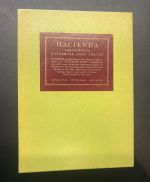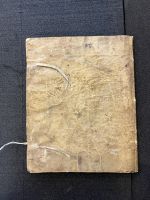Recipe book: Difference between revisions
No edit summary |
No edit summary |
||
| Line 1: | Line 1: | ||
== Overview == | == Overview == | ||
The '''Recipe Book''' is a [https://en.wikipedia.org/wiki/Manuscript manuscript] cookbook written by various women in England between the years 1600 and 1825.<ref name="catalog entry">https://franklin.library.upenn.edu/catalog/FRANKLIN_9950173773503681</ref> In some ways, there is no official "publisher" – someone who makes public a text – since it is not physically written on the book. | The '''Recipe Book''' is a [https://en.wikipedia.org/wiki/Manuscript manuscript] cookbook written by various women in England between the years 1600 and 1825.<ref name="catalog entry">https://franklin.library.upenn.edu/catalog/FRANKLIN_9950173773503681</ref> In some ways, there is no official "publisher" – someone who makes public a text – since it is not physically written on the book. The receipt book genre was popular during the [https://en.wikipedia.org/wiki/Early_modern_period early modern period], and this book contains entries for various recipes, ways to preserve food, remedies, and household tips. Housewives shared recipes and household tips with other housewives and passed them on to their daughters. The circulation of the book was casual and private. Therefore, it can be assumed that the book was owned by many women. The book also provides insights into authorship and the role of women in English society during the 17-18th century. The book was owned by King Alfred's Notebook (Cayce, S.C.), and [https://en.wikipedia.org/wiki/University_of_Pennsylvania University of Pennsylvania] acquired it in 2011. The book can be found at the [https://www.library.upenn.edu/kislak Kislak Center for Special Collections, Rare Books and Manuscripts]. | ||
| Line 7: | Line 7: | ||
You make '''bold''' text like this. | You make '''bold''' text like this. | ||
== Background == | == Background == | ||
=== Historical Context === | === Historical Context === | ||
There were no printed recipe books in the beginning, and during this time they started to circulate. | |||
=== Author === | === Author === | ||
The book is known to be written in England in the first half of the 17th century (f. 1-48), with additions from the 17th through early 19th centuries (f. 49-86). It is known that the first part of the book is the secretary hand (f. 1-48) and the later is cursive hands (f. 49-86). Since there are various handwritings, it can be assumed that more than one woman wrote the book. [https://en.wikipedia.org/wiki/Elizabeth_Grey,_Countess_of_Kent Elizabeth Grey, Countess of Kent] is known as the | The book is known to be written in England in the first half of the 17th century (f. 1-48), with additions from the 17th through early 19th centuries (f. 49-86). It is known that the first part of the book is the secretary hand (f. 1-48) and the later is cursive hands (f. 49-86). Since there are various handwritings, it can be assumed that more than one woman wrote the book. [https://en.wikipedia.org/wiki/Elizabeth_Grey,_Countess_of_Kent Elizabeth Grey, Countess of Kent] is known as one of the contributors of the book. While her handwriting is not physically in the book, she is known as a contributor. As a medical recipe collector, she wrote cures for pox, plague, and other common illnesses as well as recipes for culinary treats. The highly educated Lady Kent was known in elite circles as a collector of medical remedies. <ref name="ELIZABETH GREY, COUNTESS OF KENT RECIPES">https://www.manuscriptcookbookssurvey.org/collection/index.php/Detail/manuscripts/158</ref> | ||
== Physical Analysis == | == Physical Analysis == | ||
| Line 25: | Line 21: | ||
==== Date / Time Period ==== | ==== Date / Time Period ==== | ||
* Not physically written in the book | |||
* Known to be from around 1600-1825 | |||
==== Place ==== | ==== Place ==== | ||
* Not physically written in the book | |||
* Known to be written in England | |||
==== Publisher ==== | ==== Publisher ==== | ||
* Not physically written in the book | |||
* In some ways, there isn't really an official "publisher" -- someone who makes public a text | |||
* It is known that women who were responsible for cooking and maintaining the house wrote the book to share with other women and pass down to their daughters | |||
* Various handwritings indicate that the book is written by more than one woman | |||
==== Copyright / Licensing ==== | ==== Copyright / Licensing ==== | ||
* There is no evidence that this object was copyrighted or licensed | |||
==== Provenance ==== | ==== Provenance ==== | ||
* The book was owned by King Alfred's Notebook (Cayce, S.C.), and Penn acquired it in 2011 | |||
=== Book as Physical Object === | === Book as Physical Object === | ||
| Line 39: | Line 45: | ||
[[File:Front Cover.jpeg|150px|thumb|left|The front cover / title page of the book]] | [[File:Front Cover.jpeg|150px|thumb|left|The front cover / title page of the book]] | ||
[[File:Back Cover.jpeg|150px|thumb|left|The back cover / last page of the book]] | [[File:Back Cover.jpeg|150px|thumb|left|The back cover / last page of the book]] | ||
It has a leather cover for both the front and back with a limp vellum binding. | |||
[[File:Content 2.jpeg|150px|thumb|right|Typical page in the book/ paper and lines on it]] | |||
[[File:Stain 1.jpeg|50px|thumb|right|Stains in the corners of each page]] | |||
[[File:Stain 2.jpeg|50px|thumb|right|Stains in the corners of each page]] | |||
The book seems like it was written on a nice notebook at the time considering how old it has been and how much it would have been passed on from one individual to another. The material of the inside of the book is white paper with lines on it. While there are water stains on every page of the book in both the top and the bottom corners of the book, considering the age and use of the book, it is in good condition. | |||
==== Platform/ Format ==== | ==== Platform/ Format ==== | ||
This book object is a codex, and its bibliographic format is quarto. It is a modern foliation in pencil, lower right recto. It has a shape and format of a normal book with rectangular pages that open up with two pages each. One difference between this book and a typical book is that this book can be read either from the front or the back. | |||
==== Binding/ Structure ==== | ==== Binding/ Structure ==== | ||
The object is bounded. It is limp vellum binding, which indicates that this book is original. The binding seems to be of contemporary parchment, with two sets of ties. | |||
[[File:Front Cover.jpeg|50px|thumb|left|Limp vellum binding] | |||
[[File:Side.jpeg|50px|thumb|middle|Side] | |||
[[File:Binding.jpeg|50px|thumb|right|Binding] | |||
==== Navigation ==== | ==== Navigation ==== | ||
There is a subtitle on every page of the book indicating what the page will explain. For example, it says “For Stewed Meats,” For Sore Eyes,” and etc. The subtitle on every page helps the reader easily know what the page is talking about. It also helps the reader navigate since one might want to find instructions for a specific food or ways of doing something. These subtitles correspond to the table of contents. While the book does not follow the table of content as page numbers, it follows the number label of the recipe. For example, the image shows recipes #13 and #14. While this page may not be the 13th page of the book, the subtitle recipe and number match the table of contents. | |||
[[File:Content 1.jpeg|150px|thumb|left|Typical page in the book, current page is for recipes #13 and #14]] | |||
It is interesting to see that the later part of the book is written upside-down. This almost divides the book in two where the first part is more about the recipe for cooking and the second part is about receipt for doing other things, such as medical cures. | |||
[[File:Other side 1.jpeg|150px|thumb|right|In the later part of the book, the writings are upside-down]] | |||
==== Paratexts ==== | ==== Paratexts ==== | ||
There is no paratext for preface or dedication, but they have an index. There is a table of contents keyed to the numbers of the recipes from number 1 to 79. The table of contents is divided into smaller sections with titles, such as “For Boil'd meats,” “For stewed Meats,” “To make Pasts (pastries),” “Roast Meats,” “Fryed Meats,” “Sauced Meats,” “To Make Tarts,” and “Milk Meats (including puddings).” | |||
[[File:Table of Contents 1.jpeg|100px|thumb|left|Table of Content 1-79 – in the beginning of the book]] | |||
[[File:Table of Contents 2.jpeg|100px|thumb|left|Table of Content 1-79 – in the beginning of the book]] | |||
Then, as mentioned earlier when describing how the later part of the book is written upside-down, there is another table of contents at the end of the book that is also written upside-down (which is about the content written upside-down). | |||
[[File:Other side Table of Contents.jpeg|100px|thumb|right|Table of Content 1-33 written upside-down – at the end of the book]] | |||
=== Book Use === | === Book Use === | ||
Revision as of 18:21, 3 May 2023
Overview
The Recipe Book is a manuscript cookbook written by various women in England between the years 1600 and 1825.[1] In some ways, there is no official "publisher" – someone who makes public a text – since it is not physically written on the book. The receipt book genre was popular during the early modern period, and this book contains entries for various recipes, ways to preserve food, remedies, and household tips. Housewives shared recipes and household tips with other housewives and passed them on to their daughters. The circulation of the book was casual and private. Therefore, it can be assumed that the book was owned by many women. The book also provides insights into authorship and the role of women in English society during the 17-18th century. The book was owned by King Alfred's Notebook (Cayce, S.C.), and University of Pennsylvania acquired it in 2011. The book can be found at the Kislak Center for Special Collections, Rare Books and Manuscripts.
You make italics like this.
You make bold text like this.
Background
Historical Context
There were no printed recipe books in the beginning, and during this time they started to circulate.
Author
The book is known to be written in England in the first half of the 17th century (f. 1-48), with additions from the 17th through early 19th centuries (f. 49-86). It is known that the first part of the book is the secretary hand (f. 1-48) and the later is cursive hands (f. 49-86). Since there are various handwritings, it can be assumed that more than one woman wrote the book. Elizabeth Grey, Countess of Kent is known as one of the contributors of the book. While her handwriting is not physically in the book, she is known as a contributor. As a medical recipe collector, she wrote cures for pox, plague, and other common illnesses as well as recipes for culinary treats. The highly educated Lady Kent was known in elite circles as a collector of medical remedies. [2]
Physical Analysis
Metadata
Date / Time Period
- Not physically written in the book
- Known to be from around 1600-1825
Place
- Not physically written in the book
- Known to be written in England
Publisher
- Not physically written in the book
- In some ways, there isn't really an official "publisher" -- someone who makes public a text
- It is known that women who were responsible for cooking and maintaining the house wrote the book to share with other women and pass down to their daughters
- Various handwritings indicate that the book is written by more than one woman
Copyright / Licensing
- There is no evidence that this object was copyrighted or licensed
Provenance
- The book was owned by King Alfred's Notebook (Cayce, S.C.), and Penn acquired it in 2011
Book as Physical Object
Substrate


It has a leather cover for both the front and back with a limp vellum binding.



The book seems like it was written on a nice notebook at the time considering how old it has been and how much it would have been passed on from one individual to another. The material of the inside of the book is white paper with lines on it. While there are water stains on every page of the book in both the top and the bottom corners of the book, considering the age and use of the book, it is in good condition.
Platform/ Format
This book object is a codex, and its bibliographic format is quarto. It is a modern foliation in pencil, lower right recto. It has a shape and format of a normal book with rectangular pages that open up with two pages each. One difference between this book and a typical book is that this book can be read either from the front or the back.
Binding/ Structure
The object is bounded. It is limp vellum binding, which indicates that this book is original. The binding seems to be of contemporary parchment, with two sets of ties. [[File:Front Cover.jpeg|50px|thumb|left|Limp vellum binding] [[File:Side.jpeg|50px|thumb|middle|Side] [[File:Binding.jpeg|50px|thumb|right|Binding]
There is a subtitle on every page of the book indicating what the page will explain. For example, it says “For Stewed Meats,” For Sore Eyes,” and etc. The subtitle on every page helps the reader easily know what the page is talking about. It also helps the reader navigate since one might want to find instructions for a specific food or ways of doing something. These subtitles correspond to the table of contents. While the book does not follow the table of content as page numbers, it follows the number label of the recipe. For example, the image shows recipes #13 and #14. While this page may not be the 13th page of the book, the subtitle recipe and number match the table of contents.

It is interesting to see that the later part of the book is written upside-down. This almost divides the book in two where the first part is more about the recipe for cooking and the second part is about receipt for doing other things, such as medical cures.

Paratexts
There is no paratext for preface or dedication, but they have an index. There is a table of contents keyed to the numbers of the recipes from number 1 to 79. The table of contents is divided into smaller sections with titles, such as “For Boil'd meats,” “For stewed Meats,” “To make Pasts (pastries),” “Roast Meats,” “Fryed Meats,” “Sauced Meats,” “To Make Tarts,” and “Milk Meats (including puddings).”


Then, as mentioned earlier when describing how the later part of the book is written upside-down, there is another table of contents at the end of the book that is also written upside-down (which is about the content written upside-down).
